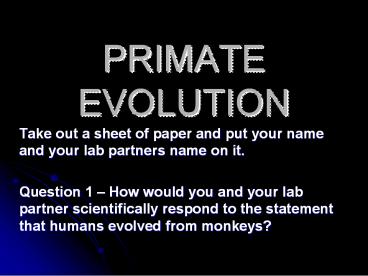PRIMATE EVOLUTION - PowerPoint PPT Presentation
1 / 22
Title:
PRIMATE EVOLUTION
Description:
New World monkeys found in Central & South America Arboreal ... comparison of similar proteins Question 6 Using 8 million years as a number, ... – PowerPoint PPT presentation
Number of Views:188
Avg rating:3.0/5.0
Title: PRIMATE EVOLUTION
1
PRIMATE EVOLUTION
- Take out a sheet of paper and put your name and
your lab partners name on it. - Question 1 How would you and your lab partner
scientifically respond to the statement that
humans evolved from monkeys?
2
Primate Adaptation Evolution
- Ch. 16, Sec. 1
3
(No Transcript)
4
Question 2 Based on the pictures from the last
slide or prior knowledge, list 4 characteristics
of all primates.
- Primates group of animals that includes lemurs,
monkeys, apes, and humans - Common traits among primates
- Large brains (relative to body size)
- Social interactions
- Flexible shoulder hip joints
5
- Opposable Thumb thumb that can cross the palm
to meet the other fingertips - Adaptation for griping climbing
6
- Binocular Vision both eyes in the front
- Better depth perception, jumping from tree to
tree - Color Vision allows primates to find food that
has most nutrition - Ex Unripe vs. Ripe fruit
7
Question 3 Explain how primate evolution has
played a role in the physical characteristics
they now possess?
- Primates share evolutionary history
- Fossil, Comparative Anatomical, DNA evidence show
a close relationship - Primates classified into 2 groups
- Strepsirrhines
- Haplohines
8
Question 4 Describe the characteristic you
would use to separate the haplorhines from the
strepsirrhines.
Primate Ancestors
Haplorhines
Strepsirrhines
Anthropoids
Hominoids
Hominids
Old World monkeys
Tarsiers
African apes
New World monkeys
Gibbons
Lorises, Pottos and Galagos
Orangutans
Lemurs
Humans
9
Humanlike Primates Evolve
- Anthropoids humanlike primates
- - hominoids
- - New World monkeys
- - Old World monkeys
- Question 5 Why do you and your lab partner
think that scientists would use the description
new world and old world to describe the
monkeys?
10
- New World monkeys found in Central South
America - Arboreal (live in trees)
- Prehensile Tail can be used as a 5th limb
11
- Old World monkeys found in Africa Asia
- No prehensile tail
- Can live in trees or on the ground
12
- Hominoids apes humans
- Apes
- No tails, walk on 2 legs w/ support from hands
- Humans
- Large brains, walk upright
13
Human Ancestry
- Ch. 16, Sec. 2
14
Hominids
- 5-8 mya in Africa a common ancestor branched off
into 2 groups (chimps humans) - Supported by DNA evidence, comparison of similar
proteins - Question 6 Using 8 million years as a number,
explain mathematically how many generations you
are from your earliest ancestors. - Hominoids primates that can walk on 2 legs
(gorillas, chimps, bonobos, humans) - Hominids bipedal primates, only walk on 2 legs
15
LICE and Body Hair
- Explain how the evolution of lice is used to
determine when the ancestors of modern humans
evolved the loss of body hair.
16
Early Hominids
- Australopithecine early hominids w/ apelike and
humanlike qualities, intermediate between chimp
and human - Lucy
- Smaller brains, bipedal
17
(No Transcript)
18
(No Transcript)
19
Modern Humans
- Humans are Homo sapiens
- Other hominids are also classified in the genus
Homo - 2.5 mya earliest hominids in the genus Homo
20
Question 7 What kinds of inferences can you
draw from looking at the skulls below?
21
(No Transcript)
22
- http//www.pbs.org/wgbh/aso/tryit/evolution/
- http//dsc.discovery.com/tv/ardipithecus/ardipithe
cus.html































